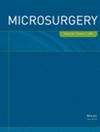Systematic review of pathologic markers in skin ischemia with and without reperfusion injury in microsurgical reconstruction: Biomarker alterations precede histological structure changes
Abstract
Background
Ischemia and ischemia–reperfusion injury contribute to partial or complete flap necrosis. Traditionally, skin histology has been used to evaluate morphological and structural changes, however histology does not detect early changes. We hypothesize that morphological and structural skin changes in response to ischemia and IRI occur late, and modification of gene and protein expression are the earliest changes in ischemia and IRI.
Methods
A systematic review was performed in accordance with PRISMA guidelines. Studies reporting skin histology or gene/protein expression changes following ischemia with or without reperfusion injury published between 2002 and 2022 were included. The primary outcomes were descriptive and semi-quantitative histological structural changes, leukocyte infiltration, edema, vessel density; secondary outcomes were quantitative gene and protein expression intensity (PCR and western blot). Model type, experimental intervention, ischemia method and duration, reperfusion duration, biopsy location and time point were collected.
Results
One hundred and one articles were included. Hematoxylin and eosin (H&E) showed inflammatory infiltration in early responses (12–24 h), with structural modifications (3–14 days) and neovascularization (5–14 days) as delayed responses. Immunohistochemistry (IHC) identified angiogenesis (CD31, CD34), apoptosis (TUNEL, caspase-3, Bax/Bcl-2), and protein localization (NF-κB). Gene (PCR) and protein expression (western blot) detected inflammation and apoptosis; endoplasmic reticulum stress/oxidative stress and hypoxia; and neovascularization. The most common markers were TNF-α, IL-6 and IL-1β (inflammation), caspase-3 (apoptosis), VEGF (neovascularization), and HIF-1α (hypoxia).
Conclusion
There is no consensus or standard for reporting skin injury during ischemia and IRI. H&E histology is most frequently performed but is primarily descriptive and lacks sensitivity for early skin injury. Immunohistochemistry and gene/protein expression reveal immediate and quantitative cellular responses to skin ischemia and IRI. Future research is needed towards a universally-accepted skin injury scoring system.

 求助内容:
求助内容: 应助结果提醒方式:
应助结果提醒方式:


